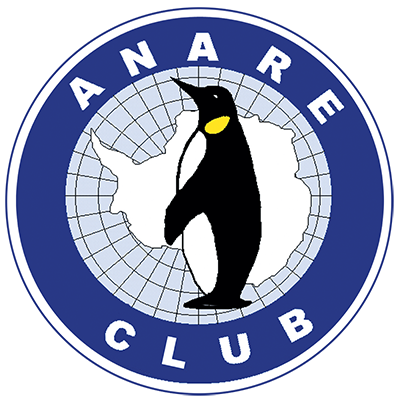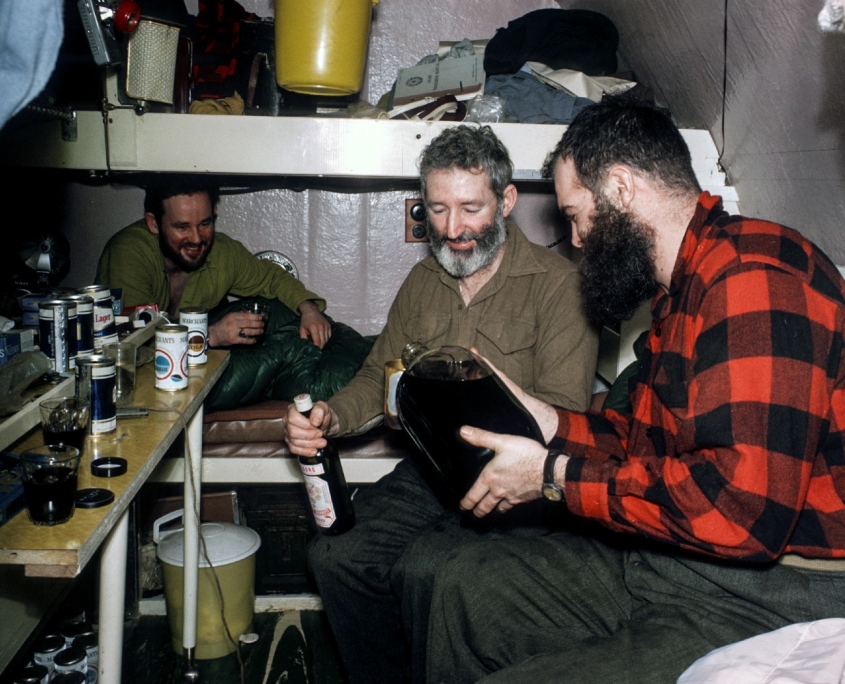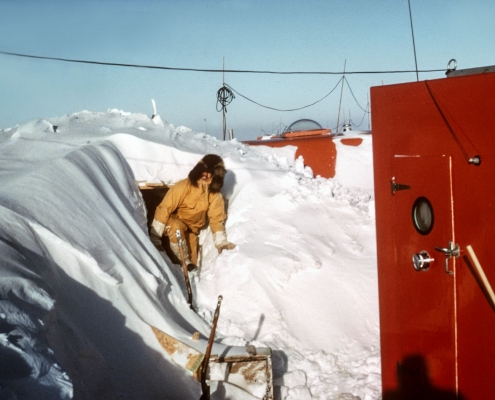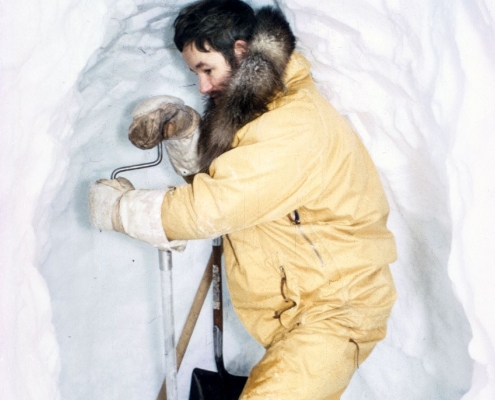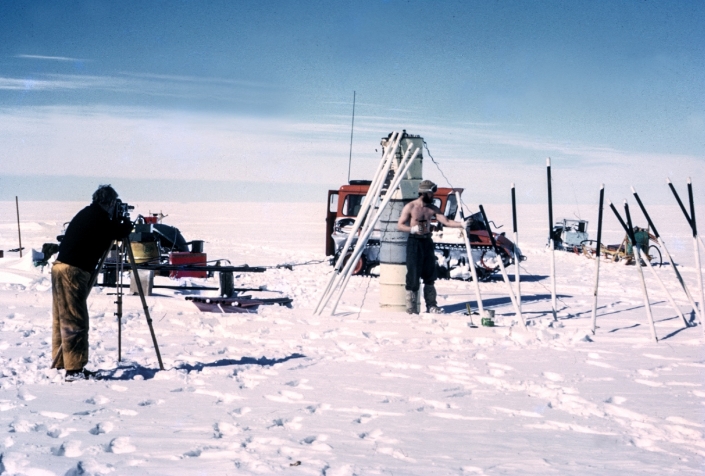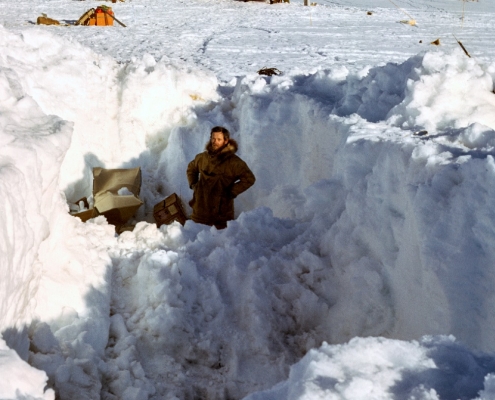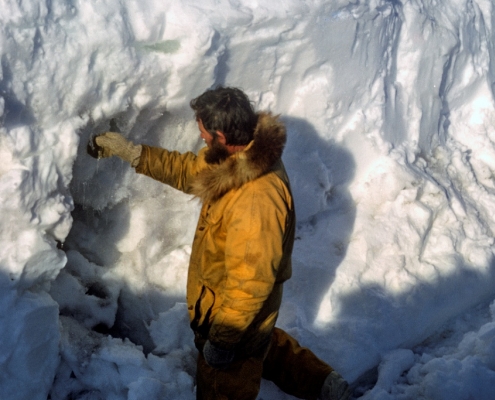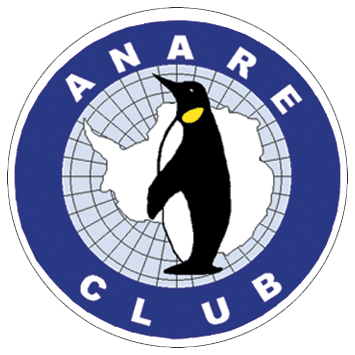Inside of the RMIT living caravan where we lived (2 per caravan). Julian in on the left, then the legendary mechanic Nev Collins (of Vostok & Prince Charles Mountains fame) then Alan Nickols, electronics engineer and communications officer.
Amery Ice Shelf – A Tribute to Julian Rupert Sansom
News has been received that the medical officer for the 1968 Amery Ice Shelf wintering team, passed away suddenly on December 29 at his rural home in the eastern portion of the Norfolk – Suffolk boundary area in England.
Julian, known to his Australian colleagues as ‘Sam’, was born in London and did his medical training at St Thomas’s Hospital in the city. After house jobs, he answered a ‘world-wide plea’ for a medical officer for a special year-long Antarctic project involving placing a party of four men for year-round studies on the Amery Ice Shelf between Davis and Mawson.
He spent some months in the usual preparations but at one time, it was proposed that he spend the year at Wilkes until another suitable doctor was appointed to that post. Unique in his preparations period were many days spent in the Antarctic Division Store with the expedition glaciologist packing the many items of field and other equipment, grouped in categories to cater for every foreseeable option of methods of getting and unloading the party on to the shelf including overland travel from Mawson.
The first entrance constructed that had to be replaced by a trapdoor system, with ice steps, on the surface.
Julian was flown in by helicopter to the proposed wintering site, then just a couple of tents and helped receive the 24 tonnes tons of cargo flown in 100 km by helicopter from the ship. Later vehicles arrived with small RMIT caravans, which were for the party to spend their time at one, two or possibly more locations on the shelf.
Originally these caravans were supposed to be able to act as a medical operating facility in case of emergency but this was not practicable. A special hut shelter of fabric was ordered for this purpose but failed to arrive in time for the ship’s departure from Melbourne. A hut being used at Mawson as a paint store after being originally suppled as a replacement toilet block, was transferred to the Amery site, and it proved better than the proposed flexible skin unit. Previous excursions to the Shelf in late spring/early summer had encountered magnificent weather conditions, but the rest of year proved much more severe than this with the building and caravans being completely buried by snow.
The party were then forced to adapt with the limited materials available, a living complex with tunnels between the caravans and the hut as well as a shower/generator shelter. Until this was completed, occupants of each caravan were forced to leave and enter the caravans by the trap door on the roof, even if visiting the other caravan.
The three other members of the party all had their appendixes removed prior to departure from Australia and ‘Sam’ once said ‘I may have given up my life for this but I am going to going to get you blokes through’. In his six chests of medical equipment there was enough surgical equipment to do three operations, probably using the chests as a suitable table. Fortunately there was no medical incidents except a case of carbon monoxide poisoning in one of the vans when the gas heater flue became blocked with frozen again water. The two occupants were one hour into a two hour lethal dose, but were rescued in time. Unfortunately two months later on the plateau behind Wilkes an expeditioner died in similar circumstances.
‘Sam’ was very much involved in all facets of the team, be it cooking most of the main evening meals, hefty work with near continuous snow removal required or improving the place to make it habitable, as well as involvement with the scientific work.
During the winter period the four men carried out the first deep drilling in the ice by an Australian team. It was very difficult with the drill being operating manually in the open with the only protection being a couple of tarpaulins strung across a couple of survey poles. The drill equipment was not designed to operate in the low temperatures prevailing at the time and even the ice cores recovered often shattered on reaching the lower temperatures at the surface. Scientific instruments had to be lowered manually down the borehole in the open conditions again without protection. After the drill had nearly reached to the bottom of the ice shelf and proving that there was some freezing of the sea to the ice itself (Julian was designated ice core analysis). Later comments on this initial Australian deep drilling was that “The very adverse operational conditions experienced on the Amery Ice Shelf severely stressed both the drill plant and its operators.”
The attention of the team then turned to discovering details of the shelf’s dynamics over its area. ‘Sam’ initially acted mainly as survey level staffman holding 4m long levelling staff vertically at distances apart ranging from 100 to 400 metres depending on the actual slope encountered. This followed routes over 500 km long, ranging from the sea at the NE corner of the Shelf to solid rock of Flagstone Bench overlooking Beaver Lake to the Prince Charles Mountains, as well as other survey legs to the side. In the subsequent survey stage Sam lone handed recorded with pencil and paper, the thousands of theodolite and distance measurements made by the glaciologist.
Inside the tunnel system drilling for snow/ice in order to obtain water after melting. The tunnel alcoves and the drill holes were also used for other purposes.
In all ‘Sam‘ travelled over 4,000 km driving a small motorized toboggan towing a traditional made dog sledge, often making repeated stops for scientific observations. With the glaciologist, this included several long, short duration trips (often in the ‘wee hours of the morning’ or ‘overnight’).
The relieving ship dropped a party to spend summer at the Amery Landing Bluff area. Members of this party were very much relieved that a medical officer became available to this expedition and that set a precedent for all future land based expeditions of this type.
Julian often said that he did not have any real scientific work, but he was determined to make a pictorial activities of the year’s activities. This he did with in spite of limited film, a damaged lens –unknown till later– and this transpired into the film Amery Ice Shelf coupled with still photographs about this different and somewhat difficult year-long activity.
The activity in painting the survey poles (three of each of these sections were joined together and erected as 6m high survey markers – in some area they lasted for more than two decades). The location is nearly 200 km south of wintering site, Julian doing the painting and the drum beacon erected here at the location known as G3 by a party travelling overland from Mawson five years previously.
You can get an idea of what was involved with the images taken after the caravans were retrieved at the end of the year.
Two features near the Amery Ice Shelf have been named for Julian. Sansom Island just to the north of Landing Bluff was later used as a helicopter staging area for flights between Davis and Mawson or the Prince Charles Mountains and had an emergency shelter erected there. The other, Sansom Ridge (discovered by the Amery Ice Shelf party according to official sources) lies east of Beaver Lake and Flagstone Bench and the western edge of the Amery Ice Shelf. ‘Sam’ himself laboured up this holding a levelling staff up and over this feature until reaching the solid rock overlooking Beaver Lake.
‘Sam’ apparently never said much about his time on the shelf, once saying to a visiting Australian ‘what happens on the Amery stays on the Amery”. This is endorsed by his recent English obituary that simply said ‘he spent a year as medical officer in the Antarctic’.
From that report we learnt that on his return to England, Julian undertook surgical training in Birmingham and was appointed consultant Surgeon in Great Yarmouth – Lowestoft area in England in 1980. He operated (‘regarded as the fastest operator on the East coast”) until his retirement at the age of 65 in 2005. He had various roles with the Royal College of Surgeons and was an honorary lecturer at the Cambridge University Medical School.
The latter stages of his life were spent in a rural setting in the same locality, devoting his time to gardening, carpentry, reading history and cosmological theory.
Julian was married to Catherine and they had a son, Nathan, and a daughter, Naomi.
Comments from a former colleague indicated “Mr Sansom was a hard-working and accomplished surgeon who got along well with all his colleagues. He was very skilled at DIY and extremely good at woodwork and will be greatly missed.”
Sounds just like the same ‘Sam’ we knew on the Amery. He made a great contribution both in the Antarctic and elsewhere.
A big thankyou to Max Corry for this wonderful contribution and images.
